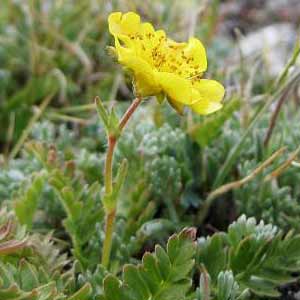Geum rossii
(synonym of Geum rossii var. depressum)
Geum aleppicum
Ross' avens
Aleppo avens, Aleppo or yellow avens, benoîte d'alep, yellow avens
4–28 cm, glabrous or downy, hairs to 1 mm, sometimes septate-glandular.
30–120 cm, hirsute to sparsely hirsute.
basal 3–13 cm, blade pinnate to interruptedly pinnate, major leaflets 13–26, alternating with 0–14 minor ones, terminal leaflet slightly larger than major laterals;
cauline 0.7–2 cm, stipules adnate to leaf, indistinguishable from pair of lobes, blade bractlike, not resembling basal, alternate, simple, pinnatifid to 3-fid.
basal 10–35 cm, blade interruptedly pinnate, major leaflets 5–9, alternating with 4–6 minor ones, terminal leaflet usually only slightly larger than major laterals;
cauline 4–19 cm, stipules ± free, 8–28 × 5–22 mm, blade pinnate to 3-foliolate.
1–3(–4)-flowered.
3–7-flowered.
woolly, sometimes glandular.
puberulent, hirsute, eglandular.
erect;
epicalyx bractlets 1.5–7 mm;
hypanthium green, slightly purple-tinged to strongly purple;
sepals erect to erect-spreading, 3–10 mm;
petals spreading, yellow, obovate to nearly orbiculate, 5–12(–17) mm, longer than sepals, apex broadly rounded to irregularly emarginate.
erect;
epicalyx bractlets 2–3.5 mm;
hypanthium green;
sepals erect but soon reflexed, 4–8 mm;
petals spreading, yellow, nearly orbiculate to broadly ovate or obovate, 5–9 mm, equal to or slightly longer than sepals, apex rounded, occasionally irregularly notched.
sessile, glabrous.
on 2–3 mm stipes, densely downy, hairs soft, 0.3–0.7 mm.
wholly persistent, not geniculate-jointed, 2–5(–10) mm, apex not hooked, glabrous throughout or pilose only at base.
geniculate-jointed, proximal segment persistent, 3–6 mm, apex hooked, bristles on basal 1/3, eglandular, distal segment deciduous, 1–2 mm, pilose in basal 1/2, hairs much longer than diam. of style.
= 56.
= 42.
Geum rossii
Geum aleppicum
The variability accommodated here in Geum rossii was distributed by earlier monographers such as P. A. Rydberg (1913b) and F. Bolle (1933) among a half dozen species. W. Gajewski (1957) reduced them to two species, G. rossii and G. turbinatum; most recent taxonomists have recognized the two taxa as subspecies or varieties of a single species. The large geographic discontinuity between the Rocky Mountain and arctic ranges makes it easy for those wishing to follow this tradition. No one morphologic character or combination of characters neatly separates the arctic plants from those of the Rockies.
Where their ranges overlap in Alaska, Geum rossii hybridizes with G. calthifolium to form sterile plants known as G. ×macranthum (Kearney ex Rydberg) B. Boivin; see discussion under 4. G. schofieldii.
(Discussion copyrighted by Flora of North America; reprinted with permission.)
In the broad area where their ranges overlap, Geum aleppicum is often confused with G. macrophyllum var. perincisum. The two taxa are similar in habit and leaf form and they occupy the same habitats. Mixed collections mounted on one herbarium sheet are sometimes seen. One macroscopic clue useful in quickly sorting herbarium specimens is the color of the dried plants. Geum aleppicum often, but not always, darkens considerably upon drying and appears blackish green; G. macrophyllum is lighter and greener. In G. aleppicum, the epicalyx bractlets are always present and conspicuous; the bractlets are relatively small or absent in G. macrophyllum. In fruiting specimens, the styles of G. aleppicum have bristles at the base and are without glands; the styles of G. macrophyllum lack bristles and are nearly always stipitate-glandular. The bristles at the base of the style are a consistent and useful characteristic in fruiting specimens of G. aleppicum. Other species of avens may have bristles on the achenes; no others (except for occasional specimens of G. laciniatum) have bristles on the styles.
Geum aleppicum hybridizes with G. rivale (= G. ×aurantiacum Fries ex Scheutz); see discussion under 8. G. rivale.
Geum strictum Aiton is a superfluous and illegitimate name for G. aleppicum.
(Discussion copyrighted by Flora of North America; reprinted with permission.)
- Local floras:
BC,
OR,
WA
- Local Web sites:
CalFlora,
CalPhotos,
Flora NW,
PNW Herbaria
WildflowerSearch
iNaturalist (observations)
USDA Plants Database
- LBJ Wildflower Center
- SEINet
- Plants of the World Online
- Encyclopedia of Life
- Wikipedia
- Google Image Search
- Local floras:
BC,
CA,
OR,
WA
- Local Web sites:
CalFlora,
CalPhotos,
Flora NW,
Go Botany,
IL Wildflowers,
MD Biodiversity,
MI Flora,
MN Wildflowers,
PNW Herbaria,
SW CO Wildflowers
WildflowerSearch
iNaturalist (observations)
USDA Plants Database
- LBJ Wildflower Center
- SEINet
- Plants of the World Online
- Encyclopedia of Life
- Wikipedia
- Google Image Search
